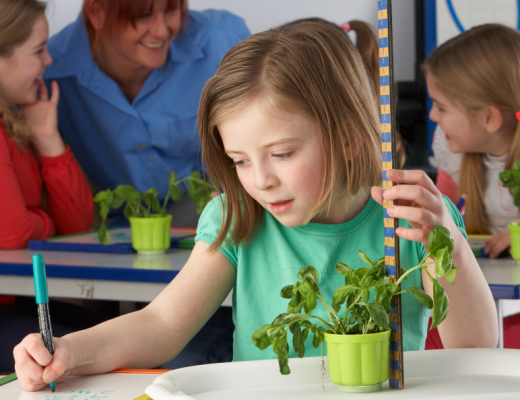Teaching about how seeds and plants grow is actually one of my favorite Springtime topics! It lends itself to a lot of hands-on activities and great read-aloud books. The best part is that it’s usually after all of our state testing has concluded. You know what that means… it’s time to enjoy the last half of the school year. And what better way to do that, than by diving deep into PLANTS

In this post, I share a few kid-friendly science videos that I like to use with my own students. I’m sure your kiddos are like mine, and LOVE watching science videos too! Just so you know, I’ve grouped the videos by topic. I think this will help you find what you’re looking for even quicker. One more thing, I tried to pick videos that are relatively short, so you shouldn’t have any problems squeezing them into your existing lessons.

My kids absolutely love watching SciShow Kid videos. That’s why I’ve included quite a few of them… This specific video is a great introduction to the process of germination. Students will learn the name of the different parts of a seed (seed coat, embryo, + endosperm) and understand the role of the seed coat. They’ll even learn that some seeds are dormant.
Once the students have learned about the different parts of the seed, let them experiment with actual seeds. I mean what better way to learn about the seed coat and an embryo than to actually observe one up close.
If you’d like to download a free science experiment exploring the inside of a lima bean sign up down below. This is sure to be a kid pleaser… My kids love this lab!
This next video is different than all the others. It’s a time-lapse video of an actual seed germinating over a period of 25 days. It’s fascinating! Your kids are going to love watching the entire process unfold right before their very eyes. Let me warn you ahead of time… you’re going to have to play this video more than once
Your kids are going to love this adorable cartoon that explains the process of germination. It goes into quite a bit of detail explaining how the seed coat falls off and how the roots grow downward seeking “nourishment” for the plant. Yes, even though it’s a cartoon, the vocabulary is there for students to soak up.
This next one is a little more advanced. I would not use it as an intro. video, but it’s definitely worth watching. It focuses on the life cycle of a flowering plant and touches on the idea that some plants produce spores instead of seeds. It also goes on to explain different ways seeds are dispersed.

This video, unlike the last one, is for the advanced learner. The narrator does a good job of making connections between plants and humans. For example, he compares photosynthesis to humans cooking in the kitchen. Love this!!!! He also compares plants drinking water from the soil to humans drinking with a straw. These connections are powerful for our little learners. That’s why even though this video might go into a little more detail than my 3rd graders need, I still think it’s worth including in this collection.

If you’re looking for a simple video that goes over the parts of a flower, their functions, the role of pollinators, and gives a brief overview of pollination, then this one is for you. My favorite part is around minute 2:49. This is when a flower is dissected or taken apart so that students can clearly identify all of its parts. Since I usually conduct this lab with my students, I thought it might be a good idea to show this video prior to conducting the lab so that students are clear on the stamen and pistil.
Bees are the main character in this video! It’s all about showing kids the importance of pollinators.
This video goes at a slower pace than the others, however, it’s still worth watching. Especially if your kiddos learn from repetition. By the end of this video, your students will be able to identify the stamen and pistil. They’ll also be able to name a few different types of pollinators. At the end, there’s even a quick quiz to test what they’ve learned.

Once you show this video, you’re going to have to conduct this lab in your class. So don’t say I didn’t warn you This video shows an experiment that involves growing plants in four different ways. One plant is given everything it needs to grow… water, soil, and sunlight. Then each of the remaining plants will lack one of the things that plants need. For example, one of the plants won’t have access to sunlight, another won’t be given water, and the last plant will be planted in the sand instead of soil.
This one is a continuation of the last video. It actually shows what happened to the four plants after some time passed. I love that the “scientist” in this video actually acknowledges a mistake she made in her experimentation process. This shows students what I’ve been teaching them all year long… we learn from our mistakes. If your kiddos are new to the experimentation process, this is a great starter video.
We’re all very familiar with the experiment that involves a stalk of celery “drinking” colored water. Well, this video shows just that. So if you’re not able to conduct the actual experiment, you can always show your kiddos this video instead.
Not all plants have to start from a seed. In this video, you’ll actually get to see how a potato is grown from another potato. If time is not on your side when it comes to conducting experiments, this video will be perfect for you. Students can actually see the entire process from start to finish.

This video goes into detail as to how plants respond to various stimuli. Specifically, it covers three types of tropisms: phototropism, gravitropism, and thigmatropism. Oh wow! Yea those are pretty complicated topics right there. Don’t worry… the video doesn’t go into a lot of detail and with your support, I’m sure 3rd and 4th graders will be able to understand what’s going on.
Thigmotropism is a plants response to touch. What better way to show students what you’re talking about, then by seeing a real-life plant that responds to touch. Be prepared, your kids are going to think this is the coolest plant ever! Don’t be surprised if they ask you to bring in a Touch Me Not to school.

Most kids have heard of a Venus Flytrap, but I bet they haven’t heard of Sundews or Pitcher Plants. Wait till they find out what those carnivorous plants do with their food.
Did you know that bananas are not grown from seeds? Yup, you heard me right! And that’s just one fun fact your kiddos will learn. This video is filled with banana facts. I guarantee you that your students are going to be in awe with this one. For example, did you know that a banana tree is not actually a tree?
Some flowers smell really good, but others are simply disgusting! This video is all about the smelliest flowers in the world. Think dirty diapers and rotten eggs… YUCK!!!!
Do you know that milky white substance that oozes out of some leaves when you pluck them off a plant? That’s actually a plant’s way of defending itself. That’s not the only “weapon” plants use to stay safe from animals. This video goes on to explain how plants, that cannot move, protect themselves from predators that can.
Don’t forget to sign up to download your free science experiment and discussion questions.
Looking For A Plant Unit To Use With These Videos
These kid-friendly videos are only part of your plant unit. There’s so much material to cover when it comes to seeds and plants, that videos alone cannot possibly cover it all. That’s why in addition to these videos, and a few read aloud books, I like to use this All About Plant Unit that includes:

- 11-page kid-friendly informational text booklet
- 7 quick checks to assess students’ understanding throughout the unit (answer keys provided)
- 3-page unit assessment (answer keys Provided)
- 35 vocabulary cards w/real life pictures
- 5 Experiments- lab sheets with discussion questions
- Writing Connection- 5 writing prompts
If you’d like to take a closer look at the complete unit click HERE or on the picture above.

If you liked the videos, feel free to Pin the image above so that you can come back to it later!
More Plant Unit Resources
*Kid-friendly books about seeds and plants
You’ll find more science resources on my Elementary Science Ideas Pinterest board and my Science: Plants Pinterest board.





No Comments